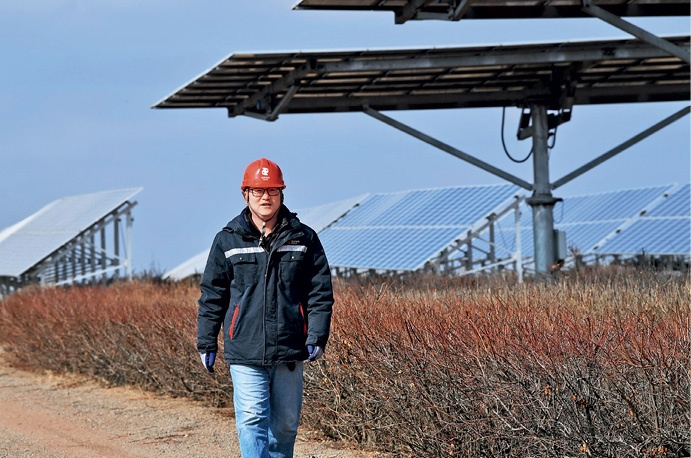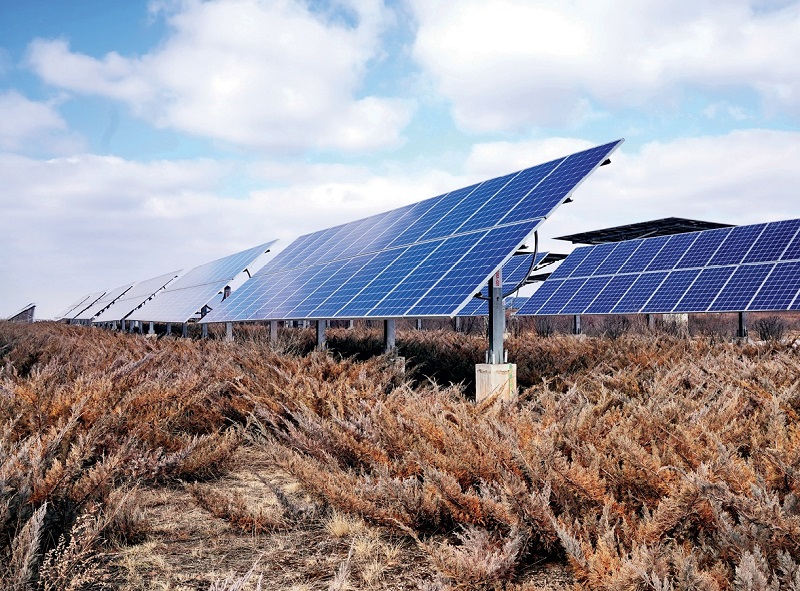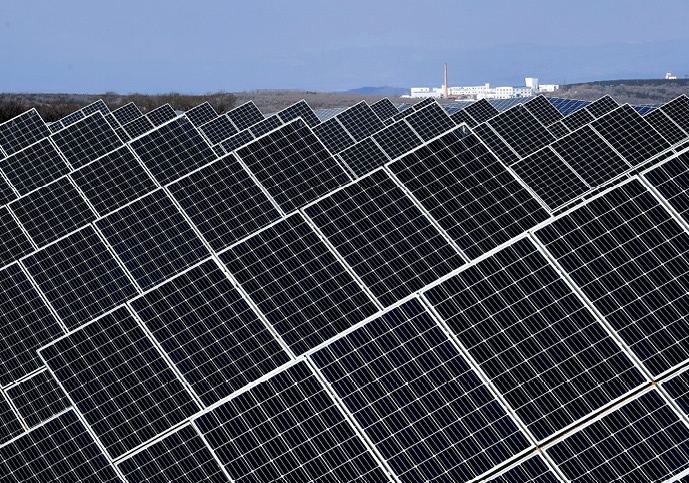At the national demonstration base of advanced photovoltaic (PV) technology in Datong City, Shangxi Province — the largest coal producer in China, rows upon rows of solar panels glitter in the sunlight, resembling a twinkling blue ocean. In the distance, a line of towering wind turbines stretch majestically across green mountains, their white blades turning slowly in the spring breeze.Technicians patrol the area, inspecting each piece of equipment to ensure they can absorb sunlight and convert it to clean energy at maximum efficiency. On their watch, green electricity is continuously fed into the power grid, ushering in an era of cleaner and more sustainable energy.

Hu Yanbiao conducts a routine inspection tour of the photovoltaic equipment at the power station.
Agrovoltaics Transforming a Mining Area
Datong’s economy has long been dependent on coal resources, and the city has played a vital role in ensuring national energy security. Large-scale coal mining over many decades, has however, caused land subsidence in areas totaling 1,687 square kilometers, forcing the villages located there to move out. As the land in these areas is unfit for farming, it was left unused, sparsely covered in trees and shrubs.
Adjacent to coal mines, these subsidence areas have easy access to the power grid. The terrain is flat, and enjoys abundant sunlight, favorable conditions to build photovoltaic power stations.
In 2015, the local government of Datong adopted a plan for establishing a PV power base in mining-induced subsidence areas. After getting approval by the state, it became the first PV technology demonstration project backed by the National Energy Administration. The first-phase project broke ground in September 2015, with the planned capacity of one million kilowatts. It was completed and connected to the power grid in June 2016, and generated 1.63 billion kWh of electricity during its first year of operation. As of the end of March 2024, the base had cumulatively generated 12.4 billion kWh of electricity — equivalent to the annual power consumption of 5.17 million households.
At the base’s Chenguang Power Station, solar panels are placed in neat and orderly rows, and beneath them grow various shrubs such as sea buckthorn. Hu Yanbiao, an engineer at the power station, explained that this is a new model of ecological restoration called solar-forest complementation. This combination of plants and solar panels not only makes efficient use of land for clean energy generation but also helps restore the ecosystem of mining-induced subsidence areas.
Currently, vegetation coverage at the base has reached 98 percent, effectively rehabilitating the land. “Planting vegetation under solar panels does not affect power generation efficiency, but rather boosts soil and water conservation. It’s a win-win solution of both economic and ecological benefits,” Hu said.

Agrovoltaics techniques enable former mining sites in Datong to restore eco-systems while revitalizing the economy.
Technology Empowers Progress
To date, the PV technology demonstration base in Datong has been in operation for nearly nine years. With technological advancements, it has continuously upgraded its PV modules.
According to Hu, in addition to fixed photovoltaic panels and those adjustable for seasonal changes, the base has introduced solar trackers that follow the sun’s movement throughout the day. These advanced panels automatically adjust their angles based on the sun’s position, rotating 0.1-0.2 degrees every 15 seconds.
“These new panels eliminate the need for manual adjustments, significantly reducing labor costs. Moreover, since they can automatically align with the sun’s trajectory, they greatly improve energy conversion efficiency and performance. Compared to traditional fixed panels, these new models can raise annual electricity output by 15-20 percent,” Hu said.
Additionally, the base uses drones for inspections and firefighting. “Our power station spans over 200 hectares. Manual inspection would be highly time-consuming for an area of this size. Drones can significantly improve our efficiency,” Hu added. “We’ve also introduced firefighting drones. Datong is dry and windy. Once a fire breaks out, it can be difficult to contain it. With their rapid response capability and precise control systems, drones can detect fires in real time and effect a quick response, safeguarding both the ecological safety of the base and the stable operation of PV installations.”
The first-phase project includes a monitoring and service center for PV power generation, which provides digital, information technology-empowered, and other specialized services for companies located at the base.
Using next-generation information technologies such as cloud computing, big data, spatial geographic information, and a 3D geographic information system (GIS), the center conducts dynamic tracking and evaluation of the equipment, production process, and core performance indicators across the base. This is critical for improving the quality of PV products, conversion efficiency, and the overall management of the base.

Row after row of solar panels in the national demonstration base of advanced photovoltaic technology in Datong City of Shanxi Province. Photos by Yu Xiangjun
The Guiding Ideology
Twenty years ago, in 2005, President Xi Jinping, then Party secretary of Zhejiang Province, made the insightful remarks “lucid waters and lush mountains are invaluable assets” during an inspection of Yucun Village in Anji County. Today, green transition is at the core of China’s economic and social development.
In its 2025 government work report China declared that it will make coordinated efforts to cut carbon emissions, reduce pollution, pursue green development and boost economic growth, accelerating the green transition in all areas of economic and social development. It will further deepen structural reform in ecological conservation and coordinate initiatives for industrial restructuring, pollution control, ecological conservation, and climate change response. In addition, it will continue to prioritize ecological protection, conserve resources and use them efficiently, and pursue green and low-carbon development.
As a national pioneer in the energy revolution, Shanxi has been dedicated to building a new energy system, striving for a balance between maintaining secure, stable power supply and achieving green, low-carbon transition. The province has steadily expanded its wind and solar power capacity, driving the energy revolution to higher levels. As of the end of 2024, its installed capacity of renewable energy had reached 61.89 million kilowatts, accounting for 50.37 percent of the province’s total power generation capacity. The green reform in Shanxi has yielded tangible results: in 2024, days with good air quality accounted for 74.2 percent of the year, an increase of 2.9 percentage points from the previous year.
Beyond ecological improvements, energy transition has also brought new opportunities for development of the digital economy. China Comprehensive Computing Power Index (2024) shows that Datong ranks third in AI computing power among 295 Chinese cities. According to Zhao Li, an official at the Datong Municipal Party Committee’s Policy Research Office, “The competition in computing power comes down to electricity supply.” In addition to coal-fired power, Datong has nurtured a diversified new energy industry, including wind, PV, and geothermal energy. This will support the city’s transformation into a computing power hub and a pillar for the Eastern Data-Western Computing Project.
Through reform and innovation, the former “coal capital,” Datong is undergoing a remarkable transformation. During the coming years, Shanxi will continue to develop green energy while enhancing ecological conservation, contributing more to China’s green development.